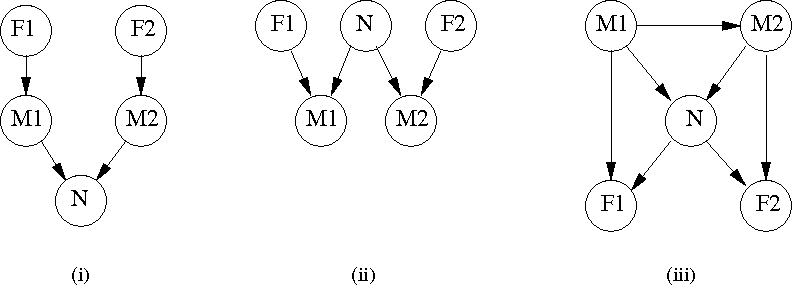


Next: d-separation [4+1* P]
Up: MLA_Exercises_2011
Previous: Conditional Independence II [2+1*
Figure:
Three possible networks for the telescope problem.
|
|
Two astronomers in different parts of the world make measurements  and
and  of the number of stars
of the number of stars  in some small region of the sky, using their telescopes. Normally, there is a small possibility
in some small region of the sky, using their telescopes. Normally, there is a small possibility  of error by up to one star in each direction. Each telescope can also (with a smaller probability
of error by up to one star in each direction. Each telescope can also (with a smaller probability  ) be badly out of focus (events
) be badly out of focus (events  and
and  ), in which case the scientists will undercount by three or more stars (or, if
), in which case the scientists will undercount by three or more stars (or, if  is less than 3, fail to detect any stars at all). Consider the three networks illustrated in Figure 1.
is less than 3, fail to detect any stars at all). Consider the three networks illustrated in Figure 1.
- a)
- [1 P]
Which of these Bayesian networks are correct (but not necessarily efficient) representations of the preceding information?
- b)
- [1 P]
Which is the best network? Why?
- c)
- [1 P]
Write out a conditional distribution for
 , for the case
, for the case
 and
and
 . Each entry in the conditional distribution should be expressed as a function of the parameters
. Each entry in the conditional distribution should be expressed as a function of the parameters  and/or
and/or  .
.



Next: d-separation [4+1* P]
Up: MLA_Exercises_2011
Previous: Conditional Independence II [2+1*
Haeusler Stefan
2011-12-06
